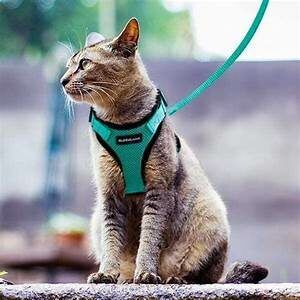In the service field, you can find three different categories that have positions for animals to fill. These are: Service Animals, Emotional Support Animals, and Therapy Animals. As to the question asked in the title of this post, “Can your cat become a service animal,” unfortunately, your cat is not eligible.
However, though he cannot fill the position of a service animal, he can become an emotional support animal (ESA) or a therapy cat. Cats meet the requirements needed to fill these two positions. They have the ideal personality to serve in these ways.
Let’s look at the explanation of the three types of service animals:
Service Animals
The only animals accepted for service animal positions are dogs and occasionally, a miniature horse. These animals, as defined by the Americans with Disabilities Act (ADA) refer to an individually trained dog who learns to do tasks for the benefit of an individual with a disability. These include physical, sensory, psychiatric, intellectual, or other mental disabilities.
Though a cat cannot be a service animal, he can fulfill a critical role. He may become either an emotional support animal or a therapy pet.
Emotional Support Animals (ESAs)

These cats provide companionship, comfort, security, and love. Many of us benefit from such a cat, as often the animal does not need to be registered as an ESA, but simply follows its natural inclinations.
ESA cats can help people who are suffering from anxiety, depression, PTSD, or a mental or emotional disability. The cat becomes a live-in therapist, and usually a constant companion.
ESAs do not require any special training. Dogs can also become an ESA, though basic obedience training for him might be helpful. Just an animal’s presence can assure relief from the symptoms of emotional or mental disability.
Some breeds of cats make better ESAs than others, so do a bit of research.
Therapy Animals
A therapy cat does not live with the people he helps. Instead, a handler or owner will bring the cat into public places, such as assisted living, medical establishments or schools. Here,

they work with patients or residents as required.
Consider these cats as working cats, with owners who volunteer the cat’s time in whatever place kitty can provide benefit. Cats give companionship, attention, and love, and as they can read body language very well, they know when people need extra love.
Therapy Animals Fit Into Two Classes
1) Animal-assisted therapy (AAT): These cats can assist people who undergo physical therapy after surgery or accidents. The cat can assist when a patient works to regain motor control skills in their limbs.
The patient can benefit simply by holding or petting the cat. This interaction becomes a part of a structural treatment plan.
2) Animal-assisted activities therapy (AAAT):
Such a therapy cat supports patients, either in assisted living situations or in nursing homes. A trained handler or psychiatrist uses therapy cats as a reassuring presence for the residents. The cat will provide comfort and support where needed.
In this program, pets “visit” people under the supervision of their handler. These visits could occur at a rehab center, hospital, nursing home, library, school, or even with a personal visit to the home.
Certain facilities will allow these animals to visit with permission and on invitation. The cat does not have additional rights in regard to air travel, no-pet housing, or in non-pet-friendly establishments.
Cats as therapy animals should fill certain requirements. These are as follows:
- Trained to wear a leash and harness

- Able to remain calm, cool, and collected in any environment
- Suitably trained
If you have an ESA cat, you cannot be denied housing, and will not have to place a security deposit.
If you have a question about which breed would make an excellent companion, get to know the cat. If you are not a people-person, you may find you can get along better with cats.
Encouraging Research Results
Research has shown definite benefits just in holding and petting a cat, for people with mental and emotional disabilities, anxiety, depression, or PTSD.
A cat does not object to just being there when he’s needed, as just his presence helps reduce stress. The cat does not need to go on a walk with you or to get regular exercise — he just needs to be loved.
Two Federal Acts Will Protect Your Rights As An ESA Owner
1) The Air Carrier Access Act (ACA) states that, if you have obtained an ESA letter for your cat, you can bring kitty on a commercial flight. If you experience anxiety or PTSD while traveling, your cat can help you. You should receive no extra charge for bringing him aboard.
2) The Fair Housing Act (FHA) says that, as a renter, if you are an owner of an ESA cat, you are entitled to live on a property without paying a pet deposit.
To ensure protection of these rights, you would be wise to register your cat as an ESA. You will receive an ESA letter, guaranteeing you and your cat receive the entitlements outlined in federal law.
To register your cat as an ESA, contact a professional, thus protecting your rights as an ESA owner. One of my references suggested using pettable.com, which determines if you qualify and then connects you with a professional who will assist you in prescribing a legally compliant ESA letter.
Though an ESA is not considered a pet, your landlord may charge a security deposit. If your animal does any damage, you may be considered responsible.
Is Your Cat Qualified To Act As A Therapy Cat?
You could volunteer your time and share your cat as a therapy animal. People need the comfort that a cat can bring. Your cat will require some training, as the animal must remain calm and accepting in many types of environments.
The cat should not find wheelchairs or people using walkers upsetting. He should have toleration for the clanging of dropped instruments or tools, active children, or people who move and speak differently.
If you have a cat who shows friendliness toward people and other animals, it’s a good sign. The cat should exhibit the traits of curiosity, calmness, and good behavior. He needs to find it comfortable to travel in a carrier; he also accepts a collar and harness and will walk on a leash.
To act as a therapy animal, the cat and owner need to receive certification. Several large organizations certify and register such teams, including Pet Partners (petpartners.org) and Love on a Leash (loveonaleash.org). Ask your vet for a suggestion of a pet therapy organization that accepts pets.

Your cat typically has to take and pass an evaluation and then take part in supervised visits for a number of hours. Then you can apply for membership. Once you and your cat become registered, the two of you can volunteer on your own at such places as hospitals, schools, nursing homes, or other local places where your services might fill a need.
Though you work as a volunteer, you will have to pay some fees to become certified and remain registered. You may incur training, evaluation, and initial registration fees, plus renewal fees afterward.
In return, as a member you get access to separate, ongoing training, and liability insurance.
Cats are well-suited to feeling emotional needs in many situations. Very often, even without an ESA certificate, the cat performs services of caring to you, and gives unconditional love. A cat can enrich your life as well as the lives of others in many ways.
References I used for this post:
allaboutcats.com/can-cats-be-service-animals

